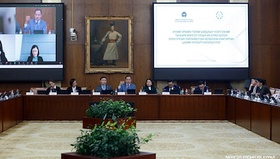MP S. Lundeg, head of the working group formed by Order No. 78 of the Chairman of the State Great Hural to review the implementation of the Environmental Protection Law, assess findings, and propose necessary legislation, shared insights on the group’s progress.
– What were the main factors behind forming a working group to review the Environmental Protection Law?
-Firstly, the long-term policy “Vision 2050” outlines a comprehensive review and update of environmental laws. Additionally, the “Billion Trees” national initiative, led by the President, has activated a national committee focused on combating climate change. Global perspectives on environmental protection are also rapidly evolving.
These developments highlight the need for a comprehensive review and update of Mongolia’s environmental laws.
Secondly, the Environmental Protection Law, adopted in 1995, has been amended nearly 30 times since. This working group was therefore established to address the gaps and needs in this framework.
– How broadly will the working group’s activities be implemented?
-The group’s initial meetings involved a detailed examination of a recent study on the coherence, overlaps, and gaps in Mongolia’s environmental laws, conducted by researchers and experts over the past two years. The study revealed that the Environmental Protection Law needs harmonization with all related sectoral laws. For example, issues related to water, forests, and land are currently governed by separate laws, which inherently affect environmental protection. However, these laws lack coherence, and certain provisions overlap, conflict, or leave gaps. We aim to map out the framework for eliminating these gaps, align the Environmental Protection Law with sectoral regulations, and potentially draft a revised version of the law to address the broader framework. The working group will therefore expand its research scope, conduct sectoral assessments, and possibly undertake fieldwork to evaluate issues like deforestation, desertification, and soil degradation in detail.
Our approach is not limited to Mongolia; it’s essential to align with global trends. For instance, Mongolian dust storms are a frequent topic at major Asian climate change conferences. Moreover, Mongolia is set to host the 17th Conference of the Parties (COP17) to the UN Convention to Combat Desertification in 2026. The working group will consider Mongolia’s obligations under international agreements and explore ways to strengthen the legal framework accordingly.
– Despite 30 years of implementation, 76% of Mongolia’s land is affected by desertification. Does this indicate the law’s effectiveness?
-This situation has multiple dimensions. Land degradation and pastureland deterioration partially result from gaps in sectoral legislation and insufficient implementation. However, global warming and accelerating climate change are impacting environmental conditions significantly. Droughts, extreme weather, and natural disasters are increasingly common, causing extensive economic and societal harm worldwide.
Mongolia, too, must adopt unified legal measures to protect nature and adapt to climate change.
The Environmental Protection Law essentially governs the relationship between people and the environment. Thus, the working group will conduct a comprehensive analysis, carefully crafting recommendations in line with the principle of “measure twice, cut once.”

 Eng
Eng  Монгол
Монгол


